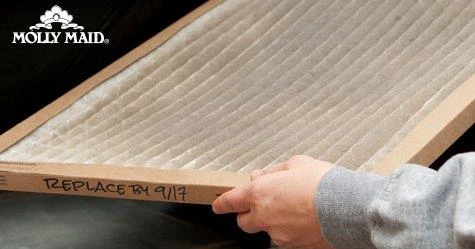
Molly Maid experts explain how to clean and when to replace household air filters for optimal air quality.
|
Furnaces, refrigerators, kitchen range hoods and some other appliances in your home use air filters. A dirty filter can cause appliances to overheat, forcing them to work harder than they have to, or even lead to contaminated indoor air quality. Some filters are hard to access, easy to forget about, or both. I mean, how many of us actually thought to clean our stove hood fan filter last year?
But keeping air filters clean is great preventative maintenance, and it also helps maintain your indoor air quality.
Read more to learn what common household appliances use an air filter, and how to replace or clean them.
How Often Should You Replace Air Filters?
The short answer is, you should at least change your filters once a year, preferably every three to six months. But it also depends on how many people are in your home, the appliance in question, if you have pets, and if you or others living with you are sensitive to allergies.
Families with more than one pet should consider changing HVAC (Heating, Ventilation and Air Conditioning) air filters every two months. For other appliances it’s important to set up a routine so you don’t forget to change the filters. Frequency is specific to the individual, but once you’ve done it a few times, you’ll begin to see a pattern of when they should be changed. Over time, you’ll develop a routine that you can put on the calendar so you don’t fall behind.
Furnace and Air Conditioning
Having clean furnace and air conditioner filters not only keeps dust and allergens out of your home, it keeps your air ducts clean. The furnace filter should be near your furnace in your home. It’s typically a replacement filter, so once you find it, pull it out to get the dimensions (they come in all different sizes). It should not require any tools to remove. Simply look for a slot where the filter can slide in and out.
For central air conditioning, it may use the same filter as your furnace, or a separate filter from where the unit pipes in cool air. You have to remove a few fasteners or the panels on the unit to access the filter depending on its location. For window-mounted units, some use a reusable filter, others use a replaceable filter—find out which one yours uses and replace it accordingly.
Your central heating and air conditioning system will also have filters for where it draws air from inside your home (return vent), you’ll want to find these filters (they’re often several) and replace them as well. Double check your length, width and depth on every filter because they’re often not all the same type or size. The furnace and return filters also come in different ratings and materials for specific HVAC systems. Make sure you find the correct replacement.
Tip: Write on the filter with a permanent marker the date you installed it. That way you can be sure to stay on top of all the routine air filter maintenance.
How to Clean Reusable Air Filters
Other common household appliances that use air filters are your stove hood fan, vacuum and dehumidifiers. These typically have filters that are reusable, which means you can simply wash and dry them and re-insert. The replacement frequency will depend on indoor air quality and how much the appliance is used. A good rule of thumb is to clean these filters every other time you replace your HVAC filters, or at the same time if they see a lot of use.
Air filter maintenance varies with the manufacturer. Please follow their recommendations.
Your hood fan filter is typically underneath the hood and looks like a wire mesh grate. Clean it with hot water and a degreaser to cut through grease. Sometimes soaking it in hot (just short of boiling) water might be necessary if it’s very dirty. Your dehumidifier air filter should also be washed with warm soapy water, or in accordance with the manufacturer’s recommendation.
Some vacuum cleaners have a pre-filter and a main filter. The pre-filter is usually reusable and traps all the large major debris before the air is filtered by a finer, replaceable filter. Clean the pre-filter out with compressed air, soapy water or a stiff brush. Follow that up with a new main filter, and you’ll be set.
Refrigerator
Again, maintenance varies with the manufacturer. Please follow their recommendation.
Some refrigerators have air filters to keep odors out of the appliance. Most manufacturers recommend changing the filter every six months. While you’re at it, you should also replace the water filter if your fridge is equipped with an ice or water dispenser. These filters are not reusable, so make sure you have a correct replacement which will be available where you purchased the unit.
If your refrigerator doesn’t have an air filter, you still have work to do. While not technically a filter, refrigerators have condenser coils where dust likes to collect. Over time, this build-up can affect the efficiency and lifespan of the unit. Remove the base grill at the bottom of the fridge and use a vacuum and stiff brush to remove any build-up. Your fridge will thank you and so will your pocketbook since this saves energy! And while you’re down there, vacuum any dust around the condenser fan.
You just did your home, your health and your wallet a huge favor — clean filters allow your appliances to work more efficiently, last longer and improve indoor air quality. It’s easy to forget about these important preventative maintenance steps, until you’re AC goes out midsummer from all of Fido’s hair in the air filter.
If you’ve noticed significant dust or debris build-up in your filters, it’s time to schedule a house cleaning. Your local Molly Maid can set you up with a regular house cleaning schedule or visit your home on a less regular basis to clean just the areas of the house that you want cleaned — like the kitchen! Contact your local Molly Maid today for a free estimate!
